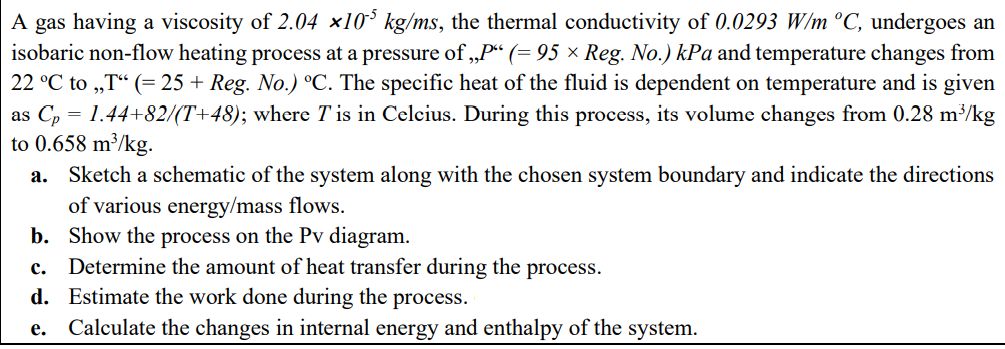isobaric non-flow heating process at a pressure of „P“ (= 95 × Reg. No.) kPa and temperature changes from 22 °C to „T“ (= 25 + Reg. No.) °C. The specific heat of the fluid is dependent on temperature and is given Cp = 1.44+82/(T+48); where T is in Celcius. During this process, its volume changes from 0.28 m³/kg as
isobaric non-flow heating process at a pressure of „P“ (= 95 × Reg. No.) kPa and temperature changes from 22 °C to „T“ (= 25 + Reg. No.) °C. The specific heat of the fluid is dependent on temperature and is given Cp = 1.44+82/(T+48); where T is in Celcius. During this process, its volume changes from 0.28 m³/kg as
Elements Of Electromagnetics
7th Edition
ISBN:9780190698614
Author:Sadiku, Matthew N. O.
Publisher:Sadiku, Matthew N. O.
ChapterMA: Math Assessment
Section: Chapter Questions
Problem 1.1MA
Related questions
Question

Transcribed Image Text:A gas having a viscosity of 2.04 x10° kg/ms, the thermal conductivity of 0.0293 W/m °C, undergoes an
isobaric non-flow heating process at a pressure of „P“ (= 95 × Reg. No.) kPa and temperature changes from
22 °C to „T“ (= 25 + Reg. No.) °C. The specific heat of the fluid is dependent on temperature and is given
as C, = 1.44+82/(T+48); where T is in Celcius. During this process, its volume changes from 0.28 m/kg
to 0.658 m³/kg.
Sketch a schematic of the system along with the chosen system boundary and indicate the directions
of various energy/mass flows.
b. Show the process on the Pv diagram.
Determine the amount of heat transfer during the process.
d. Estimate the work done during the process.
а.
с.
е.
Calculate the changes in internal energy and enthalpy of the system.
Expert Solution
This question has been solved!
Explore an expertly crafted, step-by-step solution for a thorough understanding of key concepts.
Step by step
Solved in 4 steps with 2 images

Knowledge Booster
Learn more about
Need a deep-dive on the concept behind this application? Look no further. Learn more about this topic, mechanical-engineering and related others by exploring similar questions and additional content below.Recommended textbooks for you

Elements Of Electromagnetics
Mechanical Engineering
ISBN:
9780190698614
Author:
Sadiku, Matthew N. O.
Publisher:
Oxford University Press

Mechanics of Materials (10th Edition)
Mechanical Engineering
ISBN:
9780134319650
Author:
Russell C. Hibbeler
Publisher:
PEARSON

Thermodynamics: An Engineering Approach
Mechanical Engineering
ISBN:
9781259822674
Author:
Yunus A. Cengel Dr., Michael A. Boles
Publisher:
McGraw-Hill Education

Elements Of Electromagnetics
Mechanical Engineering
ISBN:
9780190698614
Author:
Sadiku, Matthew N. O.
Publisher:
Oxford University Press

Mechanics of Materials (10th Edition)
Mechanical Engineering
ISBN:
9780134319650
Author:
Russell C. Hibbeler
Publisher:
PEARSON

Thermodynamics: An Engineering Approach
Mechanical Engineering
ISBN:
9781259822674
Author:
Yunus A. Cengel Dr., Michael A. Boles
Publisher:
McGraw-Hill Education

Control Systems Engineering
Mechanical Engineering
ISBN:
9781118170519
Author:
Norman S. Nise
Publisher:
WILEY

Mechanics of Materials (MindTap Course List)
Mechanical Engineering
ISBN:
9781337093347
Author:
Barry J. Goodno, James M. Gere
Publisher:
Cengage Learning

Engineering Mechanics: Statics
Mechanical Engineering
ISBN:
9781118807330
Author:
James L. Meriam, L. G. Kraige, J. N. Bolton
Publisher:
WILEY